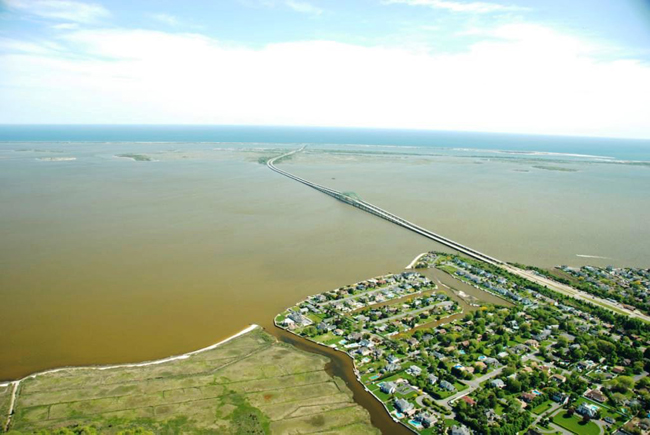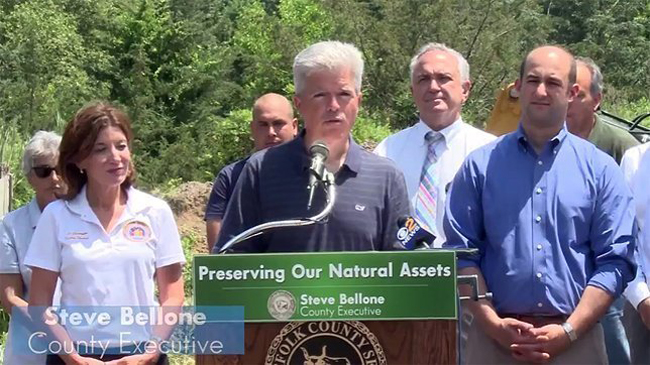
"This has been one of the worst years for brown tide and red tides that cause paralytical shellfish poisoning," said Stony Brook University researcher Christopher Gobler. This past summer, Long Island's waters experienced a 10-week-long brown tide, one of the longest and most intense on record. "What began at an ominously early time (early May) and in a strangely uncommon place (South Oyster Bay)," said Gobler, "spread to cover the entire south shore of Long Island by early June and persisted through late July in Great South Bay," which is pictured above. "As the most intense brown tide ever, it reached reaching peak intensity of 2.3 million cells per milliliter in Bay Shore in early July." Credit: Suffolk County Department of Health Services
— By Chris Gonzales, Communications Specialist, New York Sea Grant
Stony Brook, NY, October 27, 2017 - Mysterious, unusual colors in the water are signs of algae gone amok. The colorful displays disrupt marine habitats, as blooms can be a nuisance or harm ecosystem functions. Algae can even poison the family dog, or cause illness or death in humans.
As murky, algae-filled water washes up on Long Island’s coastlines, several major types of threats could be present.
William Wise, director of New York Sea Grant (NYSG), has been preparing a harmful algal blooms (HABs) action plan for Suffolk County, a year-plus-long effort. The results were released on September 25.
In an effort to reduce the severity of HABs—or at least limit their negative effects, especially those concerning public health—NYSG began working with Suffolk County Department of Health Services to prepare the plan.
The document, entitled “Suffolk County Harmful Algal Bloom Action Plan,” (pdf) lays out a strategy for monitoring, research, and management. It includes proposals for limiting nitrogen, such as upgrading septic systems; deploying seaweed farms and shellfish aquaculture facilities; and monitoring for toxins.
Christopher Gobler, associate dean for research and a professor at Stony Brook University’s School of Marine and Atmospheric Sciences, partnered with NYSG to raise awareness about HABs. He has received support from the program for nearly two decades.
In April, Gobler spoke on campus about the need to reduce the amount of nitrogen entering the water, largely due to the lack of advanced sewage treatment in Suffolk County. Suffolk County revised its sanitary codes in 2016 to promote individual on-site advanced nitrogen-reducing septic systems. Gobler believes the new regulation is a major step forward in protecting water quality.
Important sources of nitrogen on Long Island include septic systems and cesspools, agricultural runoff and residential fertilizers. Each HAB occurring in Long Island’s waters is affected differently by excessive nitrogen.
For example, the estimated mix of nitrogen deposited by humans for the Great South Bay and Peconic Estuary watersheds is between 43 and 69 percent from septic and cesspools, and when combined, the largest factor. Agricultural runoff is about 1 percent for the Great South Bay and 17 percent for the Peconic Estuary.
Experts propose upgrades to septic systems, agricultural practices, and wastewater treatment methods, as well as continued monitoring and modeling.
Action Plan

In late September, Suffolk County Executive Steve Bellone announced release of the Suffolk County Harmful Algal Bloom Action Plan. "This HAB Action Plan is yet further evidence of the County Executive's focused, sustained, and significant campaign to follow-through on that promise," said Stony Brook University researcher Christopher Gobler, who co-wrote the plan's accompanying 121-page research-focused synthesis document. Credit: Suffolk County Via YouTube
The plan itself has been developed to guide the work of multiple levels of government, scientists, and academia.
“Thanks to our work with New York Sea Grant and the Stony Brook University School of Marine and Atmospheric Sciences, Suffolk County has the very first comprehensive strategy ever developed to begin addressing the challenges of harmful algal blooms,” said Suffolk County Executive Steve Ballone.
The plan brought together scientists from across the nation with expertise in the field of HAB research.
Key report recommendations:
- Upgrade septic systems
- Promote sub-watershed projects such as the Georgica Pond pilot project
- Treat excessive nutrients in water
- Establish a management working group
- Regulate fertilizers
- Support green infrastructure projects, such as the construction of a sizeable rain garden at Centerport Beach
- Conduct real-time monitoring at Lake Ronkonkoma
- Develop a comprehensive monitoring program
- Establish a website with most current information, with a mechanism for citizens to report phenomena and receive a response
- Conduct an education and outreach program
- Assess feasibility of seaweed farms and shellfish aquaculture facilities
- Support shellfish restoration efforts
“Harmful algal blooms are a serious threat to human health, fisheries, ecosystems, and the economy in Suffolk County,” said Gobler. “This plan sets forth near- and long-term actions the County will take to prevent, control, and mitigate these HABs.”
Wise, who helped develop the plan, said, “In releasing this plan, Suffolk County gets out ahead of the harmful algal bloom issue with management actions that will reduce the frequency and severity of future blooms and sets out priorities for future HAB research funding, such as that now being sought by [New York] Senator [Chuck] Schumer through the Harmful Algal Bloom and Hypoxia Research and Control Amendments Act of 2017.”
More Info: New York Sea Grant
New York Sea Grant (NYSG), a cooperative program of Cornell University
and the State University of New York, is one of 33 university-based
programs under the National Sea Grant College Program (NSGCP) of the
National Oceanic and Atmospheric Administration (NOAA). The NSGCP
engages this network of the nation’s top universities in conducting
scientific research, education, training and extension projects designed
to foster science-based decisions about the use and conservation of our
aquatic resources. Through its statewide network of integrated
services, NYSG has been promoting coastal vitality, environmental
sustainability, and citizen awareness about the State’s marine and Great
Lakes resources since 1971.
New York Sea Grant maintains Great Lakes offices at SUNY Buffalo, the
Wayne County Cooperative Extension office in Newark and at SUNY Oswego.
In the State's marine waters, NYSG has offices at Stony Brook University
and Stony Brook Manhattan, in the Hudson Valley through Cooperative
Extension in Kingston and at Brooklyn College.
For updates on Sea Grant activities:
www.nyseagrant.org has RSS,
Facebook,
Twitter, and
YouTube links. NYSG produces a monthly e-newsletter, "
NOAA Sea Grant's Social Media Review," via its blog,
www.nyseagrant.org/blog. Our program also offers a free e-list sign up via
www.nyseagrant.org/coastlines for its flagship publication,
NY Coastlines/Currents, which is published quarterly.